
Are you fascinated by the world of reptiles and amphibians? If so, then herpetology is the perfect field of study for you. Herpetology is the scientific discipline that focuses on the study of reptiles and amphibians, including the likes of snakes, lizards, turtles, frogs, and salamanders.
From the diverse characteristics of these creatures to their intriguing behaviors and ecological roles, herpetology delves deep into the captivating world of reptiles and amphibians. Whether you’re a wildlife enthusiast, aspiring biologist, or simply curious about these unique creatures, the study of herpetology offers a wealth of knowledge and awe-inspiring discoveries.
In this article, we will explore 14 fascinating facts about herpetology that will leave you in awe of these ancient creatures. So, get ready to dive into the mesmerizing realm of reptiles and amphibians and discover the wonders that herpetology has to offer.
Key Takeaways:
- Herpetology is the study of reptiles and amphibians, helping scientists understand their vital roles in ecosystems and develop strategies for their conservation.
- From frogs’ unique breathing abilities to snakes’ flexible jaws, herpetology reveals the fascinating world of reptiles and amphibians, shedding light on their diverse behaviors and survival mechanisms.
Herpetology is the study of reptiles and amphibians.
Herpetologists dedicate their careers to understanding and researching these fascinating creatures, including snakes, lizards, turtles, frogs, and salamanders.
The word “herpetology” comes from the Greek word “herpeton.”
This term encompasses all cold-blooded, creeping animals, emphasizing the focus on reptiles and amphibians in the field.
Herpetology is crucial for understanding the Earth’s biodiversity.
By studying reptiles and amphibians, scientists gain valuable insights into ecological systems, evolution, conservation, and even medicine.
The world’s largest known reptile is the saltwater crocodile.
These impressive creatures can reach lengths of up to 23 feet and weigh over 2,200 pounds.
Frogs have a fascinating ability to breathe through their skin.
This unique adaptation allows them to absorb oxygen directly from their environment, making them highly sensitive to changes in their habitat.
Reptiles and amphibians play crucial roles in ecosystems as both predators and prey.
From controlling insect populations to serving as food for larger animals, they contribute to the delicate balance of nature.
Some reptiles, like geckos, can regenerate their tails.
If they lose their tail due to predation or injury, geckos have the remarkable ability to regrow a new one.
Amphibians are excellent bioindicators of water and environmental quality.
Due to their sensitivity to pollution and habitat degradation, their presence or absence can indicate the health of an ecosystem.
The Komodo dragon is the largest living species of lizard.
These formidable reptiles can grow up to 10 feet in length and weigh over 300 pounds.
Reptiles and amphibians have unique mating strategies.
From elaborate courtship displays and calls to complex reproductive behaviors, their methods of reproduction are diverse and fascinating.
Over 70% of known amphibians are frogs.
With around 7,000 different species, frogs are the most diverse group of amphibians, exhibiting an incredible array of sizes, colors, and behaviors.
Snakes have flexible jaws to accommodate their prey.
Thanks to their amazing ability to dislocate their jaws, snakes can swallow animals larger than their own head!
Reptiles and amphibians have been around for millions of years.
They have survived major extinction events and continue to thrive in various habitats worldwide.
Herpetologists play a vital role in species conservation.
By studying and monitoring reptile and amphibian populations, they help develop strategies to protect endangered species and their habitats.
Conclusion
In conclusion, herpetology, the study of reptiles and amphibians, is a fascinating field with a wealth of captivating facts. From the extraordinary adaptations of these creatures to their vital roles in ecosystems, there is so much to learn and appreciate about these often-misunderstood animals.Herpetology not only provides insights into the biology and behavior of reptiles and amphibians but also plays a crucial role in conservation efforts. Understanding their habitats, reproductive patterns, and ecological interactions allows scientists and researchers to develop effective strategies for their protection.Whether you’re a passionate reptile enthusiast or simply curious about the world around you, exploring the intriguing world of herpetology is sure to leave you amazed. So dive in, and discover the wonders of these unique and fascinating creatures.
FAQs
Q: What is herpetology?
A: Herpetology is the branch of zoology that focuses on the study of reptiles and amphibians. It involves researching and understanding their biology, behavior, evolution, ecology, and conservation.
Q: What types of animals are studied in herpetology?
A: Herpetology primarily focuses on reptiles, such as snakes, lizards, turtles, and crocodiles, and amphibians, including frogs, toads, and salamanders.
Q: What are some interesting facts about reptiles and amphibians?
A: Reptiles have scales, breathe air with lungs, and lay eggs, while amphibians have moist, permeable skin, undergo metamorphosis, and typically lay jelly-like eggs in water. They are known for their incredible adaptations, such as the ability to regenerate limbs and camouflage themselves.
Q: Why is herpetology important?
A: Herpetology plays a crucial role in understanding the diversity, ecology, and conservation of reptiles and amphibians. This knowledge helps in the conservation of their habitats, protecting endangered species, and promoting their coexistence with humans.
Q: How can I get involved in herpetology?
A: You can start by gaining knowledge through books, documentaries, and online resources. Additionally, joining local herpetological societies, volunteering at wildlife organizations, or pursuing academic studies in biology or zoology can provide opportunities for hands-on experiences and further involvement in herpetology.
Was this page helpful?
Our commitment to delivering trustworthy and engaging content is at the heart of what we do. Each fact on our site is contributed by real users like you, bringing a wealth of diverse insights and information. To ensure the highest standards of accuracy and reliability, our dedicated editors meticulously review each submission. This process guarantees that the facts we share are not only fascinating but also credible. Trust in our commitment to quality and authenticity as you explore and learn with us.
